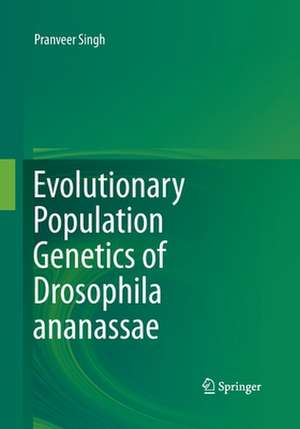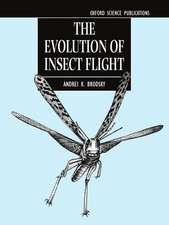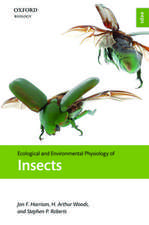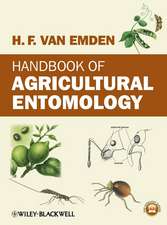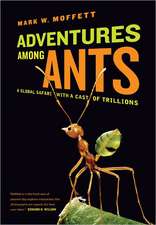Evolutionary Population Genetics of Drosophila ananassae
Autor Pranveer Singhen Limba Engleză Paperback – 23 aug 2016
This book explores some fundamental questions concerning the role of natural selection and genetic drift on the degree of inversion polymorphism. India, with its wide diversity in geo-climatic conditions, provides an excellent platform to conduct such studies. The book showcases sampling records of inversion frequencies in natural Indian populations of D. ananassae that cover more than two decades. It highlights case studies in which sampling data on inversion frequencies was combined with that from earlier surveys, generating a time series that allows the evolutionary dynamics of inversion polymorphism to be explored. Such long time series are rare but nonetheless crucial for studying the evolutionary dynamics of inversion polymorphism. The population-genetic analysis discussed is unprecedented in terms of its temporal (two decades) and spatial (most regions of India covered) scale and investigates the patterns of polymorphic system in D. ananassae to see if there is any temporal divergence. It endeavors to present a holistic picture of inversion polymorphism across the country (India).
Chromosomal aberrations, particularly paracentric inversions, are used as a tool for discussing population genetic studies, helping human geneticists, gynecologists and other medical professionals understand why some aberrations are fatal in humans, with affected embryos often not surviving the first trimester of pregnancy, while similar aberrations in Drosophila flies aid in their adaptation to the environmental heterogeneity across the globe.
| Toate formatele și edițiile | Preț | Express |
|---|---|---|
| Paperback (1) | 633.35 lei 6-8 săpt. | |
| Springer India – 23 aug 2016 | 633.35 lei 6-8 săpt. | |
| Hardback (1) | 640.88 lei 6-8 săpt. | |
| Springer India – 29 oct 2015 | 640.88 lei 6-8 săpt. |
Preț: 633.35 lei
Preț vechi: 745.11 lei
-15% Nou
Puncte Express: 950
Preț estimativ în valută:
121.23€ • 131.73$ • 101.90£
121.23€ • 131.73$ • 101.90£
Carte tipărită la comandă
Livrare economică 21 aprilie-05 mai
Preluare comenzi: 021 569.72.76
Specificații
ISBN-13: 9788132234258
ISBN-10: 8132234251
Pagini: 106
Ilustrații: XI, 106 p.
Dimensiuni: 178 x 254 mm
Greutate: 0.22 kg
Ediția:Softcover reprint of the original 1st ed. 2015
Editura: Springer India
Colecția Springer
Locul publicării:New Delhi, India
ISBN-10: 8132234251
Pagini: 106
Ilustrații: XI, 106 p.
Dimensiuni: 178 x 254 mm
Greutate: 0.22 kg
Ediția:Softcover reprint of the original 1st ed. 2015
Editura: Springer India
Colecția Springer
Locul publicării:New Delhi, India
Cuprins
1. Population Genetics: An Introduction.- 2. Drosophila ananassae.- 3. Geographical distribution of Inversion Polymorphism.- 4. Population Structure and Gene Flow.- 5. Chromosomal Associations in Natural and Laboratory Populations of Drosophila ananassae.- 6. Chromosomal aberrations in Drosophila ananassae.
Recenzii
“This volume begins with a review of population genetic concepts and a description of the evolutionary forces that shape genetic variation within and among populations. … for readers who are interested in learning about chromosomal inversion variation in nature and/or are interested in population genetic history and structure of D. ananassae as a model organism, I would recommend this book.” (Roman Yukilevich, The Quarterly Review of Biology, Vol. 92 (3), September, 2017)
Notă biografică
Dr. Pranveer Singh was born in Lucknow, Uttar Pradesh, India on July11, 1976. Dr. Singh did his graduation in Zoology, Botany and Post graduation in Zoology with specialization in cytogenetics, both from university of Allahabad, Uttar Pradesh, India in the year 1998 and 2000 respectively. Dr. Singh completed his doctoral thesis in evolutionary population genetics from Banaras Hindu University (BHU), Varanasi, Uttar Pradesh, India in the year 2007.
He did his postdoctoral study (2008-2012) as a UGC-DS Kothari Postdoctoral Fellow in biophysics/proteomics from Indian Institute of Science (IISc), Bangalore, Karnataka, India. At IISc, his work involved protein engineering of HIV envelope protein to design an immunogen to be used as a subunit vaccine for HIV-1. This work was funded by International AIDS vaccine initiative (IAVI), USA. Currently, he is working as Assistant Professor in department of zoology, Indira Gandhi National Tribal University (IGNTU), Amarkantak, Madhya Pradesh, India. He has already published three books: Surface Plasmon Resonance; Chordates: Comparative Account of Physiology and Chordates: Origin, Affinity and Evolution with Nova Scientific Publishers, New York, U.S.A. His research interests include, Biophysics, proteomics, vaccine design, protein folding-unfolding kinetics, epidemiology of diseases, evolutionary genetics, and population genetics.
Dr. Singh is currently senior member of Asia-Pacific chemical biology and environmental engineering society (APCBEES). Dr. Singh is awarded with national level fellowships for doctoral and postdoctoral studies. Dr. Singh has served in various university level committees.
He did his postdoctoral study (2008-2012) as a UGC-DS Kothari Postdoctoral Fellow in biophysics/proteomics from Indian Institute of Science (IISc), Bangalore, Karnataka, India. At IISc, his work involved protein engineering of HIV envelope protein to design an immunogen to be used as a subunit vaccine for HIV-1. This work was funded by International AIDS vaccine initiative (IAVI), USA. Currently, he is working as Assistant Professor in department of zoology, Indira Gandhi National Tribal University (IGNTU), Amarkantak, Madhya Pradesh, India. He has already published three books: Surface Plasmon Resonance; Chordates: Comparative Account of Physiology and Chordates: Origin, Affinity and Evolution with Nova Scientific Publishers, New York, U.S.A. His research interests include, Biophysics, proteomics, vaccine design, protein folding-unfolding kinetics, epidemiology of diseases, evolutionary genetics, and population genetics.
Dr. Singh is currently senior member of Asia-Pacific chemical biology and environmental engineering society (APCBEES). Dr. Singh is awarded with national level fellowships for doctoral and postdoctoral studies. Dr. Singh has served in various university level committees.
Textul de pe ultima copertă
This book introduces readers to classical population genetics and the ways in which it can be applied to practical problems, including testing for natural selection, genetic drift, genetic differentiation, population structuring, gene flow and linkage disequilibrium. It provides a comprehensive monograph on the topic, addressing the theory, applications and evolutionary deductions, which are clearly explained using experimental results. It also offers separate chapters on origin, establishment and spread of chromosomal aberrations in populations along with details of culturing, maintaining and using Drosophila ananassae (genetically unique and the most commonly used species along with D. melanogaster) for genetic research. Encompassing topics like genetics, evolution, Drosophila genetics, population genetics, population structuring, natural selection and genetic drift in considerable detail, it provides a valuable resource to undergraduate and postgraduate students, as well as researchers at all level.
This book explores some fundamental questions concerning the role of natural selection and genetic drift on the degree of inversion polymorphism. India, with its wide diversity in geo-climatic conditions, provides an excellent platform to conduct such studies. The book showcases sampling records of inversion frequencies in natural Indian populations of D. ananassae that cover more than two decades. It highlights case studies in which sampling data on inversion frequencies was combined with that from earlier surveys, generating a time series that allows the evolutionary dynamics of inversion polymorphism to be explored. Such long time series are rare but nonetheless crucial for studying the evolutionary dynamics of inversion polymorphism. The population-genetic analysis discussed is unprecedented in terms of its temporal (two decades) and spatial (most regions of India covered) scale and investigates the patterns of polymorphic system in D. ananassae to see if there is any temporal divergence. It endeavors to present a holistic picture of inversion polymorphism across the country (India).
Chromosomal aberrations, particularly paracentric inversions, are used as a tool for discussing population genetic studies, helping human geneticists, gynecologists and other medical professionals understand why some aberrations are fatal in humans, with affected embryos often not surviving the first trimester of pregnancy, while similar aberrations in Drosophila flies aid in their adaptation to the environmental heterogeneity across the globe.
This book explores some fundamental questions concerning the role of natural selection and genetic drift on the degree of inversion polymorphism. India, with its wide diversity in geo-climatic conditions, provides an excellent platform to conduct such studies. The book showcases sampling records of inversion frequencies in natural Indian populations of D. ananassae that cover more than two decades. It highlights case studies in which sampling data on inversion frequencies was combined with that from earlier surveys, generating a time series that allows the evolutionary dynamics of inversion polymorphism to be explored. Such long time series are rare but nonetheless crucial for studying the evolutionary dynamics of inversion polymorphism. The population-genetic analysis discussed is unprecedented in terms of its temporal (two decades) and spatial (most regions of India covered) scale and investigates the patterns of polymorphic system in D. ananassae to see if there is any temporal divergence. It endeavors to present a holistic picture of inversion polymorphism across the country (India).
Chromosomal aberrations, particularly paracentric inversions, are used as a tool for discussing population genetic studies, helping human geneticists, gynecologists and other medical professionals understand why some aberrations are fatal in humans, with affected embryos often not surviving the first trimester of pregnancy, while similar aberrations in Drosophila flies aid in their adaptation to the environmental heterogeneity across the globe.
Caracteristici
Encompasses all topics in population genetics under single head Population genetics theory, applications and evolutionary deductions are explained by experimental results making it easier to understand Elaborates on culturing, maintenance and the use of Drosophila ananassae (genetically unique and most used along with D. melanogaster) for genetical research
